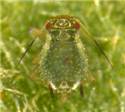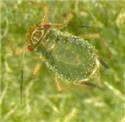Classification
Aphidinae: Macrosiphini
Common name(s)
Green chrysanthemum aphid, pale chrysanthemum aphid
Diagnosis
Very small, green aphids (1.0-1.7 mm), found on stem and underside of leaves of cultivated chrysanthemum. Siphunculi vary in pigmentation from dusky just at the apex to almost wholly dark, symmetrically swollen just before apex. Antennae 0.6 times as long as body, posterior half dark brown. Processus terminalis 1.5-1.75 times as long as base of last antennal segment. Ultimate rostral segment with six short secondary hairs. Siphunculi almost twice as long as cauda, but in younger nymphs little less, gently clavate. Cauda with 4-5 hairs.
The aphid is found in association with A. gossypii and M. sanborni. The aphid has the peculiar habit of settling in the notches of the serrated leaves of the host plant.
Distribution
Europe, North America, New Zealand, Africa. Throughout south India.
Host plant(s)
Asteraceae: Chrysanthemum sp.
Measurements
Aptera: Length of body 1.46, width 0.79; antennae 0.88, segments III: IV: V: VI 0.19: 0.12: 0.11: (0.11+0.19); u.r.s. 0.11; h.t.2 0.08; siphunculus 0.32; cauda 0.18.
Seasonal occurrence
June-July and September-October.
Natural enemies
Coleoptera: Coccinellidae: Cheilomenes sexmaculata (F.), Oenopia kirbyi Mulsant.
Hymenoptera: Braconidae: Aphidiinae: Lysaphidus quadrii Shujauddin




